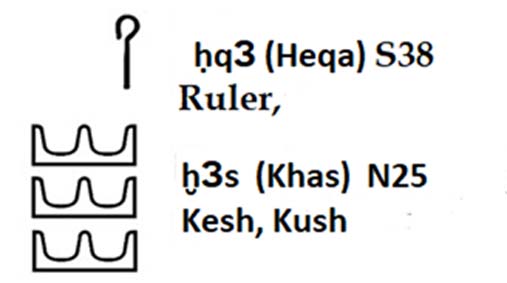To the Greeks and Romans there were two Kush empires, one in Africa and the other in Asia. Homer alluded to the two Kushite empires when he wrote in the Odyssey i.23: “a race divided, whom the sloping rays; the rising and the setting sun surveys”. In the Iliad. i.423, Homer wrote that Zeus went to Kush to banquet with the blameless Ethiopians .
In 64 BC, the Greek geographer and historian Strabo stated in Chapter 1 of Geography that there were two Kush empires - one in Asia and another in Africa. In addition to Kush in Nubia and Upper Egypt, some Greco-Roman authors considered their presence in southern Phoenicia up to Mount Amanus in Syria.
It is interesting that Apophis and the other rulers of the Hyksos, were Kushites not Amorites. The names of the Hyksos were not Semitic, they were just names the Kushites in Asia gave themselves.
The Hyksos did not call themselves Amru, they called themselves heqa khasut . Apophos on his seals and a monumental doorjamb from Avaris made it clear he was heqa khasut, King of the Kushites.

This is epigraphic evidence indicating that the Hyksos called themselves Kings of the Khas. The Hyksos worshiped Seth, the god of Avaris, and Ra. Please site a source where the Hyksos called themselves Amorites in their seals.

Most researchers have translated heqa Khas as “King of foreign lands,” but this is an incorrect translation because the Hyksos Kings were rulers of Egypt - not a foreign land. I believe that Apophis and the other Hyksos kings were acknowledging their Kushite origins. They used Khas in reference to the fact that, although they came from Asia, they were Kushites. This view is supported by the fact that the term Khas was only used to refer to the rulers of Kush during the Old Kingdom and the area around Avaris and Sharuhen during the Second Intermediate Period.

The Hyksos were Hattians. The Hattians worshipped Kasku and Kusuh. The Hatti controlled the city state of Kussara. Kussara was situated in southern Anatolia. The Hatti were especially prominent in the Pontic mountains. Hatti’s sister nation in the Halys Basin were the Kaska tribes. The Kaska and Hattians share the same names for their gods, along with personal and place names. The Kaska had a strong empire which was never defeated by the Hittites.
The Hatti were probably one of the Kushite tribes in Nubia during the Old Kingdom. During the Fifth Dynasty of Egypt (2563-2423) in the reign of Sahure there is mention of the Tehenu people.
The C-Group people occupied the Sudan and Fezzan regions between 3700-1300 BC and were called Tmhw (Temehus). The Temehus were organized into two groups: the Thnw (Tehenu) in the North and the Nhsj (Nehesy) in the South.
Sahure referred to the Tehenu leader as “Hati Tehenu”. The name Hati corresponds to the name Hatti - a tribe in Anatolia. However, the Hatti people often referred to themselves as Kashkas.
We learn from the Weni Inscription that the Kushites who lived in Nubia, were also called Khas. Breasted’s translation of the Weni Inscription indicates that Heqe Khasut was not always translated as ‘Kings Foreign “, the original meaning of ḥḳЗ (Heqa) ḫЗs (Khas), was “Kings Negroland “, as indicated in the Breasted translation. There was no such place as ‘Negroland’, it was a Eurocentric term where Blacks were supposed to live. So, the actual meaning of Heqa Khasut was ‘King Khas’ or king of the Kushite. Thusly, the inscription of Weni reads:
“His majesty made war on the Asiatic Sand-dwellers and his majesty made an army of many ten thousands; in the entire South, southward to Elephantine, and northward to Aphroditopolis [Busiris]; in the Northland on both sides entire in the [stronghold], and in the midst of the [strongholds], among the Irthet khas, the Mazoi khas, the Yam khas, among the Wawat Khas, among the Kau khas, and in the land of Temeh.”
Egyptian Khas corresponds to Kashkas, the name for the Hattians. This means that N25 represented the name Kash and Khas for the ethnonym Kushite during the 5th Dynasty of Egypt. Breasted made up the term Khasut. The Egyptian term Khasut has three N25 signs for the ethnonym Khas: Kas(ka)/Kush. Breasted made up the term Khasut, by adding the /-u/ which is the Egyptian plural marker, and the Egyptian /-t/ which is a suffix that signified 'land, people'. But in the actual inscription there is no /-u-t/ signs, there was just three N25 signs in Heqa Khas. The three Khas signs made the reading plural, i.e., Khasites =Kushites.

During the 5th Dynasty of Egypt, the Kushites lived in hilly areas. Thus, the Egyptians often referred to the Kushites as hill people. This is supported by the various meanings of Gardiner's Egyptian sign N25. The N25 sign from Gardiner’s List of Egyptian Signs; xЗs Khas or kЗs, meaning Kush.